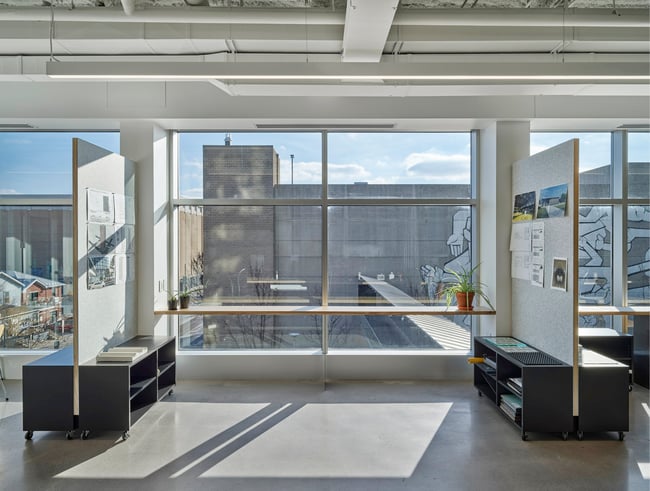WELL vs. Fitwel: Which System is Right for Your Project?

With many building certifications available, it can be difficult to determine which aligns with your project and goals. While some systems are more holistic—covering everything from energy consumption to material specifications—others have a narrower focus.
WELL and Fitwel are two systems focused on human health and well-being. Popular in the corporate sector, both systems offer frameworks for boosting occupants’ moods, improving productivity, and reducing absenteeism and turnover.
While WELL and Fitwel are similar, they differ in many ways. Understanding their differences can help you find the right fit.
This article will help you with your choice by comparing WELL and Fitwel and discussing the pros and cons of each option.
What is WELL?
WELL is a building certification system developed by the International WELL Institute. Its standards help encourage movement, facilitate social connection, and improve air, water, and light quality. Although it fits most building types, it has become popular in the corporate sector.

WELL provides a path for improving air and light quality.
Like other building certification systems, WELL’s framework is point-based. Its points are based on ten categories called Concepts, including:
- Air
- Water
- Nourishment
- Light
- Movement
- Thermal comfort
- Sound
- Materials
- Mind
- Community
Building owners and design teams work to implement WELL’s strategies, and after construction is complete, the project will undergo a Performance Verification with a testing agent. The agent will spend one to three days on-site validating the project’s documentation and completing a series of performance checks.
Depending on the outcomes achieved, projects can earn one of four certifications: Bronze, Silver, Gold, or Platinum.
What is Fitwel?
Like WELL, Fitwel provides design strategies and operational practices that improve occupant well-being. Its standards were developed by the Centers for Disease Control and Prevention (CDC) and the General Services Administration (GSA) based on academic studies from public health experts, physicians, and building designers. Today, the Center for Active Disease (CAD) oversees the program, with the CDC remaining as a research and evaluation partner.
Seven overarching goals—called Impact Categories—guide the Fitwel system. These goals include:
- Impact community health
- Reduce morbidity and absenteeism
- Support social equity for vulnerable populations
- Instill feelings of well-being
- Enhance access to healthy foods
- Promote occupant safety
- Increase physical activity
While seeking to fulfill these goals, Fitwel’s recommended strategies differ across projects. Rather than apply the same standard to all buildings, it has scorecards specific to the building type. These scorecards include:
- Senior housing
- Multi-tenant base building
- Multi-tenant whole building
- Single tenant building
- Commercial interior space
- Retail
- Multifamily residential building
Along with its building scorecards, Fitwel provides pathways for site development, including its Community and Commercial Scorecard and the Industrial Site Scorecard. Projects seeking certification are judged against the standards outlined in the applicable scorecard, and depending on the outcomes achieved, Fitwel awards one of three ratings: One Star, Two Star, or Three Star.
Its certification process includes a double-blind review. Two independent consultants review the project’s documentation and confirm a numerical score without seeing the other’s response. Typically, this process takes 12-16 weeks, though becoming a Fitwel Champion can shorten the timeline.
What Are the Differences Between WELL and Fitwel?
Although both WELL and Fitwel focus on human health within the built environment, they differ in many ways.
One key difference is how each system scores and evaluates projects. While WELL applies an overarching standard to all projects, Fitwel provides separate scorecards for different project types. For example, the strategies recommended for a senior housing facility differ from those recommended for a multi-tenant commercial building.
Fitwel also lacks prerequisites. WELL requires some strategies for certification, but with Fitwel, project teams can choose which strategies to implement. For example, if you miss points for daylighting, you can make up the points in other areas. While Fitwel offers more flexibility, it lacks the rigor associated with WELL.
Similarly, WELL’s certification process tends to be more in-depth, with a testing agent visiting the site to measure performance metrics. A Fitwel certification, on the other hand, is based on building drawings and documentation.
WELL’s performance-based approach has created an esteemed reputation, and many of the world’s largest companies have pursued a WELL certification to demonstrate their commitment to employee well-being. It comes with name recognition and can be a powerful marketing tool in competitive labor and real estate markets.
Due to its rigorous approach, WELL has higher certification fees. Fitwel is more affordable, making it accessible to a wider range of organizations.

Both systems can showcase your commitment to employee well-being.
Both systems require an ongoing commitment to health and well-being. A Fitwel certification lasts three years, after which organizations must reapply. Under current WELL standards, its certifications also last three years. However, some WELL features require annual reporting, and you will need to provide ongoing documentation to prove you are maintaining the standard.
In general, Fitwel is less demanding than WELL. It provides a verifiable, research-based approach to improving human health but is quicker to implement than other options.
WELL, on the other hand, has a slightly more prestigious reputation. While Fitwel lacks some of the rigor WELL offers, it works well for smaller organizations or those on a shorter project timeline.
Discover Other Building Certification Systems
For organizations committed to human health and well-being, WELL and Fitwel are sound investments. Both systems are research-based and provide verifiable strategies for improving mental and physical health.
The right choice depends on your budget, timeline, and goals. While WELL provides a higher level of rigor, Fitwel is more affordable and accessible. It is also more tailored to individual projects, with separate scorecards for different building types. Your design team can help you weigh the pros and cons of each option.
For organizations wanting a more holistic approach to sustainability, WELL and Fitwel may not go far enough. Instead, they may opt for a system like Leadership in Energy and Environmental Design (LEED) or Living Building Challenge (LBC).
In addition to human health, these systems address energy, water, material sourcing, and site development. Learn more by reading about the differences between LEED and LBC.